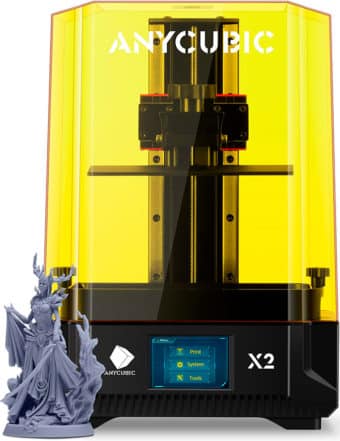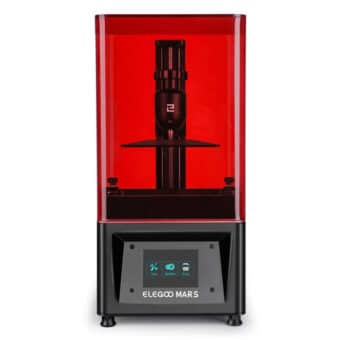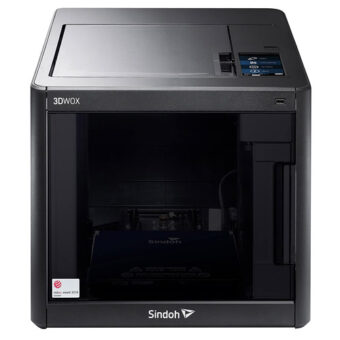There is more to 3D printers for miniatures than you know. Whether creating new accessories for your action figures, adding to a table display, or even creating household items, this expensive yet intriguing method of creating items is one that everyone’s dipped into in some capacity. Some schools have classes that revolve around 3D printing miniatures, and plenty of companies rely on them for modeling plans; if you are interested, we have prepared a detailed review so you can choose the best 3d printer for miniatures; let’s get started!
Our Top Picks
- Editor’s Choice: ANYCUBIC 4K Photon mono X2
- Best for D&D Minis: ELEGOO Mars 2 Pro
- Best for Beginner: Comgrow Creality Ender 3 Pro
- Best but Expensive: Ultimaker 2+ 3D Printer
- Best Value for Money: Sindoh 3DWOX DP200
What is the best 3D printer for miniatures?
On the other hand, this list will go through what might be a good selection of the best 3D printers for miniatures that might suit you better. Given the recent interest in these items, you should better understand what to expect from these selections regarding features, quality, and ease of access. Our five options will be broken down before you read the article’s buying guide.
1. ANYCUBIC 4K Photon mono X2 – Editor’s Choice
FEATURES
- It makes a significant amount of accuracy and detail found in a CAD file
- Models take 2-3 hours to be made, regardless of their total amount
- The printer’s components are made with professional care
- It comes with a 2.8-inch SmartTouch Color Screen
- Off-line printing base measures 4.53 x 2.56 inches x 6.1 inches
The first 3D resin printer on this list is the ANYCUBIC 4K Photon mono X2, which comes with a 2.8-inch SmartTouch Color Screen as well as an off-line printing base measuring 4.53 inches by length, 2.56 inches by width, and 6.1 inches by height. Considered the Editor’s Choice among the listed 3D printers for miniature printing, the ANYCUBIC 4K Photon mono X2 makes for an easy introduction to the hobby of 3D printing thanks to the accessible software and a limited number of settings compared to an FDM printer.
PROS
- Good build quality for the printer itself/improves from FDM printers
- Models remain accurate to their CAD files
- Printing time remains the same, regardless of the number of miniature models made
CONS
- Included resin not made for mechanical parts
- 65mm size may seem small for some
2. ELEGOO Mars 2 Pro – Best for D&D Minis
FEATURES
- Comes with a brand new version of the CHITUBOX Slicing Software
- Software dissects into model files within a minute
- Make a model hollow before the slicing procedure
- Results will still look good, thanks to the 40-watt UV lights
- It comes with a screen measuring 2560×1440 with 2K HD masking
The ELEGOO Mars 2 Pro Photocuring LCD 3D Printer doesn’t skimp out on its beefy attributes. You can’t have a 3D printer for minis without software that’s more accessible, and a touch screen to go over your files before the printing session even begins works as a cherry on top of this wonderful device. With all that and an LCD screen that measures 2560×1440 and comes with 2K HD masking, this is a 3D printer that D&D fans would not want to skip!
PROS
- Screen size works wonders for those obsessed with high levels of detail, especially for the D&D above fans.
- Files load a lot faster with the CHITUBOX Slicing Software than with open-sourced software
- It comes semi-assembled to save time with completing the rest of it
CONS
- Horizontal cracks may manifest from cleaning the UV cover with window cleaners containing alcohol
- Some users may find the LCD screen vulnerable to damage from UV light over time
3. Comgrow Creality Ender 3 Pro – Best for Beginner
FEATURES
- The Creality Ender 3 Pro 3D Printer is made specifically for beginners
- Has the ability to resume printing whenever it’s turned off by accident
- The printer also comes with an open-source code
- The ability to share any changes users made to their printer is also included.
While it may be a little pricier than the other two printers mentioned so far, it at least provides some features of its own to stand out from what’s already been mentioned. Kids will love trying the Comgrow Creality Ender 3 Pro 3D Printer out thanks to its easy assembly and halfway built. The STEM Projects that come with the printer are a fun addition to their learning skills, and it can allow them to share whatever they came up with for their friends to try out in terms of printer settings. Overall, it’s very safe for kids to use as it would be for adults; both would love to tap into some “best 3D printer for figurine” thoughts as they go deep with their creativity.
PROS
- Great for beginners to try out
- A neat way for kids to learn about 3D printing miniatures and STEM programmings
- A decent size for anyone to use
CONS
- Bolts may come loose over time
- Nozzles may seem a little small
4. Ultimaker 2+ 3D Printer – Best but Expensive
FEATURES
- It comes with nozzles of different sizes to use for printing
- Materials made with much better construction
- Print quality with ABS materials
- Fancaps with better airflow than before
- A large number of accessories
- Supports older software like Windows XP Professional, Mac OS X 10.6, and Linux Ubuntu 12.10, among others
As the fourth printer of this list, the Ultimaker 2+ has got quite the contrast in price compared to the other ones mentioned so far. While it’s got more value for money in its features and build quality, it’s most certainly worth mentioning that it’s far more expensive and has a lot more weight than what’s already covered on the list. Even the accessory account is impressive, including items you wouldn’t expect to find, like glue sticks and grease. Regardless, this is still a great printer for those with a bigger budget.
PROS
- The best build quality mentioned is found in a 3D printer for creating miniatures
- A large number of accessories are included with the printer itself
- It doesn’t make any overly loud noises while it prints miniature models
CONS
- The price is a lot higher than it should be
- Printing miniatures process does take a bit more time than needed
5. Sindoh 3DWOX DP200 – Best Value for Money
FEATURES
- It comes with an auto-loading cartridge.
- WiFi connection is included.
- Comes with a heatable metal bed (extra adhesives not required)
- Features integrated camera
- Loads and unloads its filament with ease
- The bed leveling feature is better calculated
Last but certainly not least is the Sindoh 3DWOX DP200 3D Printer, this Red Dot Design Award winner is certainly made for the expert designers that want more of a premium experience than ever before. It’s the second most expensive 3D printer on this list, but it thankfully has more value for money than the Ultimaker 2+ 3D Printer. Thanks to its features and varying forms of connectivity to share digital files online, the Sindoh 3DWOX DP200 Printer becomes necessary for any 3D designer wanting that special bang for their buck. There are many benefits from using this printer, and the connectivity options are extremely versatile; whether a user has a USB cable or flash drive, WiFi, or Ethernet, this device won’t fall short with its users.
PROS
- Value for money despite being the second-most expensive 3D printer on the list
- A built-in camera as well as a touch screen that is both easy to use on this device
- Versatile connection options for its users to try out.
CONS
- Multiple color parts can’t be printed automatically
- Filament availability is limited for this printer
Buying Guide
With these five printers finally covered, it’s time to go over the buying guide if you’re a beginner to this hobby. While you may want to diverge into your buying path as time passes, this article advises you on what’s recommended based on your current budget and what you would need out of a printer rather than what you want.
Your Budget:
You may want to go for a 3D printer that’s not too expensive. The first two (ANYCUBIC and ELEGOO) make for great options as their prices are nowhere near as high as the fourth and fifth printers on the list (Ultimaker and Sindoh). You’ll need a lot of money before even considering buying one.
Feature Quantity:
The Comgrow 3D printer, despite being a bit more expensive than the first two offerings, is at least great to buy if you want to learn what it takes to make a tabletop miniatures 3D model. The features are also a noteworthy aspect of selecting your printer of choice; let’s assume you are a beginner at 3D printing and want to learn all about the basics of the hobby before delving into the other, more complicated tasks. That way, you may better understand how the pursuit works before getting a more complex printer.
Accessories:
How many do you need, and how many tasks with said accessories would you tackle? Ultimaker’s printer has a wide selection of accessories, but do you want to keep track of them if you’re not experienced, or would you prefer to keep things simple with the other printers? These questions should be considered, but plenty of answers would normally be found in a FAQ list related to 3D printers.
FAQ
How does 3D printing work?
3D printing differentiates itself from regular printing quality by letting you turn a digital file into a physical object. It was a feat done by manufacturers in the past, and now it’s grown more accessible in recent years for schools and households. Anyone with a 3D printer can create whatever item they please if they make a digital file beforehand. The options are so limitless that you can create something simple, like a small figurine or pieces that make up a brand-new toy or accessory.
What is the appeal of a 3D printer?
There’s so much that can be done with a 3D printer, especially for those with a lot more imagination than usual; aside from adding to already existing objects or making new items, it’s easy to delve into a career of some kind, whether you’re interested in selling products that are 3D printed or even be hired for a company involved with creating items.
What is the best time to delve into 3D printing?
This hobby is best recommended if you have the finances to buy the printer, as well as getting the filament needed to create your items and even work on maintenance for the printer. Those involved with running a school or a small company would have no real issue if they had the experience of using a 3D printer, but those who use one for personal reasons will need to learn a lot more about taking care of it. Some cons alluded to quality control being a concern, so be sure to know when to reach out to the company behind these printers and understand what might lead to the issues you run into.
Final Verdict
Now that you’ve gotten an idea of what to expect from 3D printers, it’s easy to assume that they’re a very complex yet fascinating piece of technology that grows in popularity over the years, whether you want to add to the items you already own or want to make use of your imagination and create a new item altogether. These five options are the best 3d printers for miniatures you can find, whether you want one with value for money in mind or one with a rich amount of features and accessories to use when needed. All you need is the experience in creating digital files before actually getting one of the five printers mentioned above, but whatever option you are going with, whether it’s said to be the best there is, has a great price while still being good, or is made for beginners in mind, there is no doubt that you will have nothing but enjoyment from purchasing a 3D printer.










